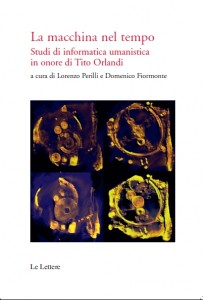Domenico pointed me to an entry on InfoLet (a blog he and others keep in Italian on informatics and literature.) The entry announces a book La macchina nel tempo: Studi di informatica umanistica in onore did Tito Orlandi that brings together many of the top digital humanists in Italy to celebrate Tito Orlandi’s contribution to the field. You can order online at http://www.lelettere.it. Here is the blog entry translated into English:
Tito Orlandi was one of the founding figures in Italy and Europe of the Digital Humanities, known in Italy as “Informatica Umanistica”, an expression coined by Orlandi himself in the late 80s. To celebrate his stuture and his outstanding contribution to the field, a group of scholars of different humanities backgrounds collected their contributions in this book not only to pay homage to the discipline but to give an account of its state of the art.
Though distinctive in nature and authorship, the essays composing this book are connected one another through the principle of methodological homogeneity with original studies in classical philology, modern archeology, linguistics, formal logic, musicology, history, textual analysis, and library sciences. All the essays provide interesting insights and reflections that go beyond the boundaries of the single disciplines of reference pointing out decisive, and still currently unsolved, knots such as the relationship between information studies and humanities or the concept of encoding as a passage from the world of analogical objects to the world of digital ones.
Almost paradoxically, nowadays the great achievements in the field of information technology seem to coincide with the great concerns of the Digital Humanities: the superficiality of the applications, the lack of transparency in the processes of digitalization, the linguistic and geopolitical supremacy of a restricted part of the scientific community, and last but not least, the risk of loss or manipulation of cultural memories.
The very topicality of the above-stated concerns shows, just like the contributions contained in this book do, that the Digital Humanities is “alive” more than ever and ready to pick some of the most important fruits of its labors. Still open, instead, is the fascinating and ambitious challenge issued by Tito Orlandi himself in the 80s: the quest for a convergence between natural and cultural sciences capable to go far beyond the mere applicative horizon.
(trans. by Federica Perazzini with edits by Geoffrey Rockwell.)
ESSAYS and CONTRIBUTIONS
Edoardo Ballo and Massimo Parodi, “Strumento e teoria”.
Domenico Fiormonte and Teresa Numerico, “Le radici interdisciplinari dell’informatica: logica, linguistica e gestione della conoscenza”.
Dino Buzzetti, “Oltre il rappresentare. Le potenzialità del markup”.
Fabio Ciotti, “La rappresentazione digitale del testo: il paradigma del markup e i suoi sviluppi”.
Gino Roncaglia, “Alcune note su modelli diversi di organizzazione ipertestuale”.
Claude Cazalé Bérard, “Ritratto dell’Ipercritico da giovane”.
Maria Guercio, “Gli archivi digitali”.
Lorenzo Perilli, “Filologia ieri, oggi … e domani”.
Alberto Cadioli, “Dall’ipersaggio” all’archivio”.
Nicola Tangari, “Informatica, musica, musicologia”.
Serge Noiret, “Storia Digitale: sulle risorse di rete per gli storici”.
Paola Moscati, “Venti anni di «Archeologia e Calcolatori». Aspetti e momenti”.
Maurizio Lana, “Un database testuale per il latino tardo”.
Ilaria Bonincontro, “Edizioni critiche in formato elettronico”.
Francesca Tomasi, “Informatica Umanistica: iniziative, progetti e proposte”.
